Ways to install Ubuntu on Windows, run in parallel or run separately
Ubuntu is an operating system built on Linux platform with a very friendly and very popular interface.
You want to try this operating system on your computer but are not sure where to start, there are many ways to enjoy Ubuntu, you can even install it right in Windows and uninstall from Control Panel If you don't like to use it anymore. Ubuntu can be booted from a USB or CD drive and used without installation, setup in a virtual machine, or in parallel installation with Windows. The following methods will help you do this.
Experience Ubuntu on Windows computers
- Are you ready to switch?
Which Linux version should you choose?- Ways to experience Ubuntu on Windows computers
- 1. Install Ubuntu Linux from Microsoft Store
- 2. Install Ubuntu directly from USB or a CD
- 3. Install Ubuntu on Windows with Wubi
- 4. Run Ubuntu on a virtual machine
- 5. Install parallel to Windows
- 6. Ubuntu online experience
- 7. Replace Windows with Ubuntu
- How to uninstall Ubuntu
Are you ready to switch?
The first thing to do is find out if you're ready to switch to Linux. The fact that you are reading this article is a good sign that you tend to want to try Linux, and the ideal place to start is Ubuntu.
In fact, Linux is not the same as Windows. Ubuntu is the most accessible Linux distribution, offering both an intuitive user interface and a reliable package manager.
If you're brave enough, you can think about using Ubuntu as your new main operating system, completely replacing Windows. To do this, you'll need to understand how you can move your data from Windows to Ubuntu (assuming it's the version you'll switch to).
Which Linux version should you choose?
As you know, there are many Linux distributions available. Some are for hardcore enthusiasts, while other distros come with a Windows-like user interface, designed to help new people switch to Linux from the Windows platform for easier access, and Ubuntu is a perfect choice.
With the appearance of Windows Subsystem for Linux, you can run Linux on your Windows 10 computer quite easily. Some Linux distributions are available as Microsoft Store applications, such as Ubuntu, Debian, SUSE Linux and even Kali Linux.
Ways to experience Ubuntu on Windows computers
1. Install Ubuntu Linux from Microsoft Store
To install any Linux version on Windows, you will first need to install Windows Subsystem for Linux .

Right-click on Start and open Windows PowerShell (Admin), then enter this command:
Enable-WindowsOptionalFeature -Online -FeatureName Microsoft-Windows-Subsystem-Linux Wait until the process is complete, then when prompted, enter Y to restart your computer.
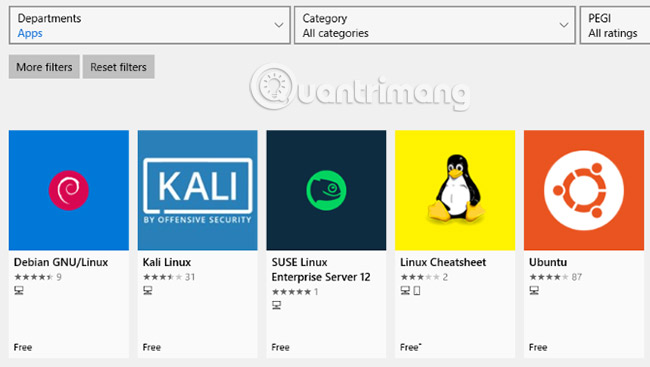
When Windows restarts, go to Windows Store, download and install your favorite Linux distro. (This feature is only available on Windows build 16215 and above. For best results, upgrade Windows to the latest version).
The installation process will take several minutes. Once completed, launch the Linux application and wait until the setup is complete.
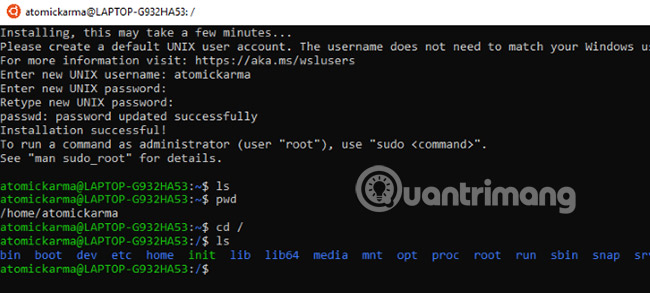
You will then be prompted to create a UNIX account by entering a new username and password. Note there is no need to use the current computer account.
So you've finished installing Linux on Windows and have many options for bash options. Now it's time to experiment with Linux from within Windows!
2. Install Ubuntu directly from USB or a CD
One of the easiest ways to get started with Ubuntu is to create a bootable USB disk directly or on a CD drive. This means that after setting up Ubuntu on the device, you can insert the USB, CD or DVD into any computer you need to use and restart the computer. Depending on the type of motherboard, the way to boot from a USB or CD is different, this does not require any changes on your computer's hard drive.
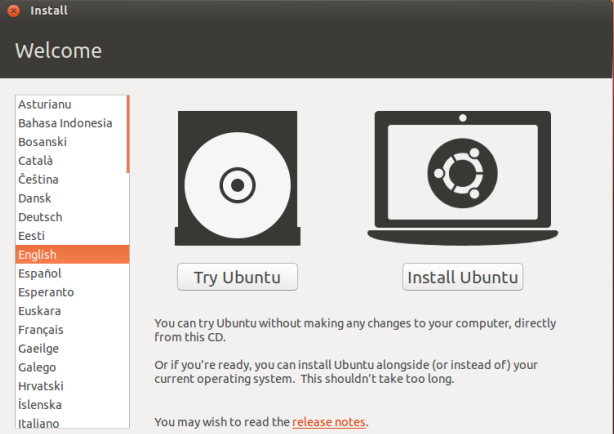
To prepare for this installation, you must first download the Ubuntu installation image file from the home page . Then use the Unetbootin utility to set up USB flash or burn the image file directly to a CD. (On Windows 7, you just need to right click on the .ISO file and select Burn disc image to burn to disk without using any other software).
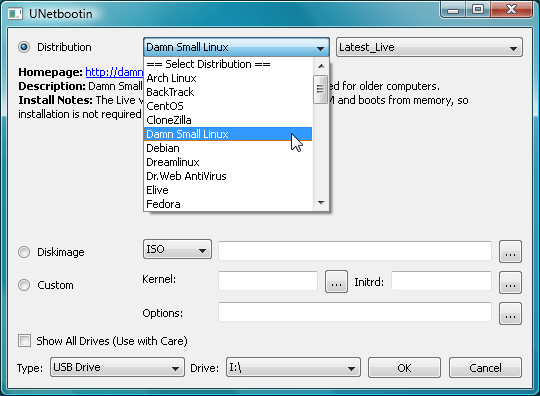
In addition, there is Linux Live USB Creator, this tool supports you all the steps to create a bootable USB to run Linux from choosing, download the desired distribution to select the format suitable for USB and create a USB boot .
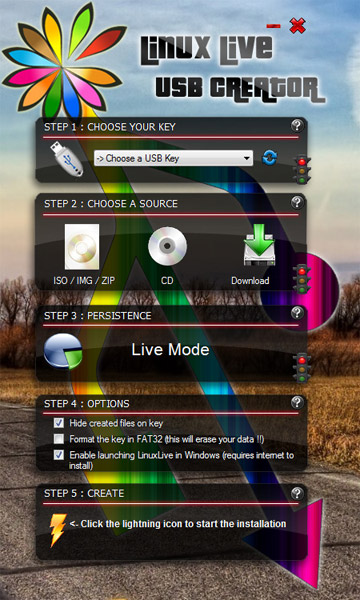
After creating the USB, it can be installed on another computer or installed directly on your computer by rebooting, entering the BIOS, choosing to boot from USB to boot into Linux instead of Windows operating system.
3. Install Ubuntu on Windows with Wubi
Usually, installing a Linux platform on a hard drive is not an easy task for beginners. It involves the ability to resize existing partitions to make room for the new operating system. If you decide you don't want to use Linux anymore, you'll have to delete the new partitions, then resize the old partition to regain space and continue to repair Windows.
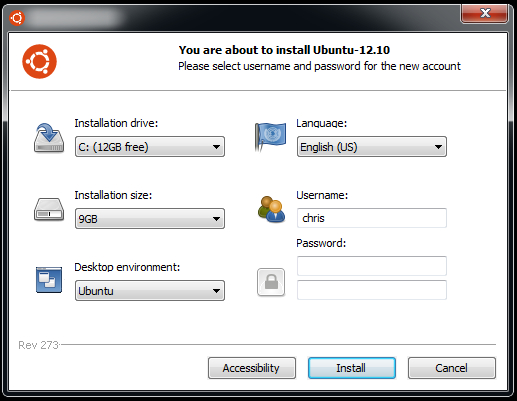
Another method to try Ubuntu is to install it on Windows with Wubi , Wubi runs just like any other application and installs Ubuntu into a file on your Windows partition. Very simple, just one click, the Wubi window is activated, it will require some necessary parameters such as user name, password, partition name and size, then click Install button to proceed with installation. put.
When restarting the computer, on the boot screen, there is an option to boot Ubuntu or Windows, Ubuntu will run as if it was installed normally on your hard drive. Another great thing is, if you don't like to use it, you can uninstall it from the Control Panel window like uninstalling an application that isn't needed with the necessary partitions.
4. Run Ubuntu on a virtual machine
Like other operating systems, Ubuntu can be run in a virtual machine through a software on the computer. Virtual machines are used to run Ubuntu in an existing Windows window or a Mac, and with this method you do not need to reboot the computer, however virtual machines often run slower than when running directly. on the computer.
- How to install and use Kali Linux on VmWare virtual machine
To create a virtual machine that installs Ubuntu, you can use one of the two most popular tools today is VirtualBox and VMWare Workstation. All you need to do is, build the virtual machine and provide the .ISO file downloaded from the Ubuntu home page when requested and then proceed with the setup steps, finally installing Ubuntu as on the computer. really.
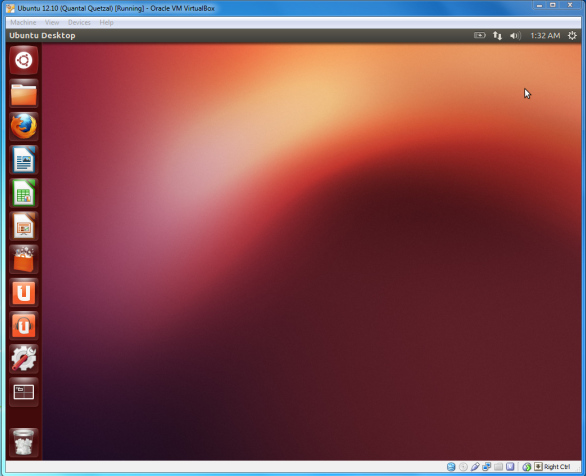
5. Install parallel to Windows
On the one hand want to use Linux, but still want to leave existing Windows on your computer, you can install Ubuntu in a dual-boot configuration like two Windows operating systems together. Just copy Ubuntu Installer to a USB, CD or DVD drive using the same method as Method 1.
When it comes to restarting your computer, choose Install Ubuntu instead of Try Ubuntu , go to the next installation screen, and check the Install Ubuntu option with Windows . Windows here depends on the version you are using, be it Windows XP, Windows 7, Windows 8. Unlike the Wubi method, because you are installing Ubuntu on your own partition, and of course You cannot remove the operating system from Windows Control Panel if you do not want to use it anymore.
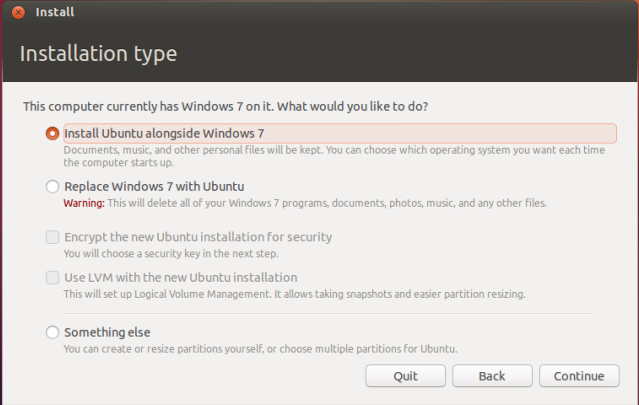
6. Ubuntu online experience
You can visit http://tour.ubuntu.com/en/, where you can see Ubuntu's overview interface, experience the feeling of surfing the web in Firefox, view basic folders, even write Text on LibreOffice, . If you love creativity, the interface is not colorful but still "quality" you will be convinced at first sight. A link to download the Ubuntu operating system is available to download and install if you want it.

7. Replace Windows with Ubuntu
Once you're ready to leave Windows, you can replace all installed versions of Windows with Ubuntu (or any other Linux distribution). To do this, proceed with the normal Ubuntu installation as described above, but check the Replace Windows with Ubuntu option . This option is not for most users unless the person does not want to keep anything of Windows.
If you're not familiar with Ubuntu's new interface or work that requires Windows, but you still like the Ubuntu experience, installing Windows in parallel with Ubuntu is the perfect choice. Of course, the only downside to installing Ubuntu in parallel with Windows is that it requires a computer configuration, and you still use normal, fast, smooth Ubuntu when installing it alone on your computer.
How to uninstall Ubuntu on Windows
In case you realize that Ubuntu Linux is not suitable for you and your productivity is severely reduced, the best thing you can do is switch back to Windows.
If you have used Live CD or virtual machine so far, this is not a problem.
However, if you install Ubuntu to dual boot with Windows, you can freely switch to the main operating system and delete Ubuntu from your hard drive. Fortunately, this is relatively simple and can be done safely, without losing any important data in the computer.
This process involves backing up your Linux data to an external device, then switching to Windows to delete the partition and restore the MBR.
Conversely, if you decide you want to convert, you really like this new operating system. You can install Ubuntu as your computer's only operating system, ideal for bringing new breaths to an old computer or enjoying new features on modern devices.
After setting up and running Ubuntu, it's time you need to capture the new operating system. Please refer to the article Tips and Tricks after installing Ubuntu if you need any help.
Wishing you good work!
See more:
- Instructions for managing programs in Ubuntu via the command line
- Install Ubuntu in Windows using the Wubi Installer
- Installing Ubuntu in VirtualBox does not need DVD or USB
You should read it
- Instructions for installing Ubuntu on VMware Workstation - Part 2
- Install Ubuntu in Windows using the Wubi Installer
- How to prolong the life of Ubuntu 18.04 installation with Ubuntu Pro
- Instructions for installing Ubuntu Maverick in Mac Virtualbox
- Instructions on how to install Ubuntu on VirtualBox virtual machine
- Setting up Ubuntu virtual machine with Hyper-V Quick Create on Windows 10
- Instructions for installing Ubuntu on VMware Workstation - Part 1
- What's New in Ubuntu 21.10?
May be interested
- How to install Android in parallel with Windows by Remix OS
 producer jide has updated remix os 3.0 dual boot to support 32-bit and 64-bit windows platforms, enabling you to install android in parallel with windows.
producer jide has updated remix os 3.0 dual boot to support 32-bit and 64-bit windows platforms, enabling you to install android in parallel with windows. - Instructions for installing Ubuntu parallel to Windows 10 easily
 ubuntu is an open operating system familiar to many programmers, as well as it people.
ubuntu is an open operating system familiar to many programmers, as well as it people. - How to install DEB file in Ubuntu
 how do you install deb files? there are several ways to install a deb package on ubuntu. the article will show you one by one in this tutorial.
how do you install deb files? there are several ways to install a deb package on ubuntu. the article will show you one by one in this tutorial. - How to Install Ubuntu in Windows
 this wikihow teaches you how to install and run ubuntu linux on your windows computer's desktop. you'll use a free program called virtualbox to do so; this will allow you to run ubuntu without having to replace your current operating...
this wikihow teaches you how to install and run ubuntu linux on your windows computer's desktop. you'll use a free program called virtualbox to do so; this will allow you to run ubuntu without having to replace your current operating... - How to install µTorrent (uTorrent) in Ubuntu 20.04
 µtorrent provides clients for windows and macos x, however it is installed as a server in ubuntu linux and provides a web ui for managing downloads.
µtorrent provides clients for windows and macos x, however it is installed as a server in ubuntu linux and provides a web ui for managing downloads. - Instructions for installing Ubuntu on VMware Workstation - Part 1
 for some reason, can't you continue to use windows (royalties)? you want to discover a certain operating system that is enough to replace the already familiar windows? you just need 1 software, some operating system to meet the needs of working very simple? check out the free and completely open source ubuntu operating system.
for some reason, can't you continue to use windows (royalties)? you want to discover a certain operating system that is enough to replace the already familiar windows? you just need 1 software, some operating system to meet the needs of working very simple? check out the free and completely open source ubuntu operating system. - How to install AVG Antivirus on Ubuntu
 in addition to windows, you can install avg antivirus on ubuntu easily and quickly to ensure that damage is minimized in the most optimal way. along with tipsmake, see how to install avg antivirus on ubuntu below.
in addition to windows, you can install avg antivirus on ubuntu easily and quickly to ensure that damage is minimized in the most optimal way. along with tipsmake, see how to install avg antivirus on ubuntu below. - How to install Putty SSH Client on Ubuntu 20.04 LTS
 in this article, tipsmake.com will explain how to install putty on ubuntu 20.04 lts system. the same process can be used for debian, mint and earlier ubuntu releases.
in this article, tipsmake.com will explain how to install putty on ubuntu 20.04 lts system. the same process can be used for debian, mint and earlier ubuntu releases. - 10 reasons to choose Ubuntu 12.10 instead of Windows 8
 according to the review, ubuntu 12.10 is more than windows 8 in many ways such as unity user interface, customization capabilities, hardware requirements, security ... after the open source os ubuntu 12.10 'quantal quetzal' is officially announced. dad, ubuntu's home page has a challenging slogan: 'avoid the pain of windows 8'.
according to the review, ubuntu 12.10 is more than windows 8 in many ways such as unity user interface, customization capabilities, hardware requirements, security ... after the open source os ubuntu 12.10 'quantal quetzal' is officially announced. dad, ubuntu's home page has a challenging slogan: 'avoid the pain of windows 8'. - How to Install Windows from Ubuntu
 this wikihow teaches you how to install windows 10 on a pc that's already running ubuntu linux. before you get started, make sure you've already purchased a windows license and product key. don't worry if you don't have windows install...
this wikihow teaches you how to install windows 10 on a pc that's already running ubuntu linux. before you get started, make sure you've already purchased a windows license and product key. don't worry if you don't have windows install...










 How to troubleshoot Ubuntu problems does not start
How to troubleshoot Ubuntu problems does not start How to install Kali Linux dual boot on macOS
How to install Kali Linux dual boot on macOS Basic Linux commands everyone needs to know
Basic Linux commands everyone needs to know How to copy and rename files in Linux
How to copy and rename files in Linux How to completely delete a file in Linux so that it cannot be restored
How to completely delete a file in Linux so that it cannot be restored How to check open ports in Linux
How to check open ports in Linux